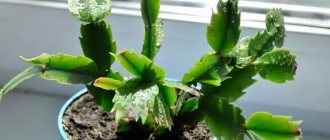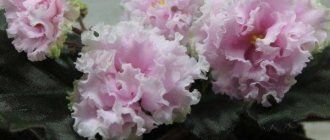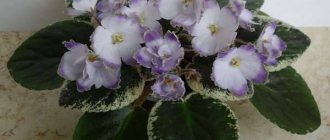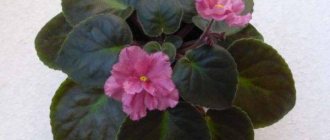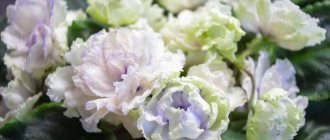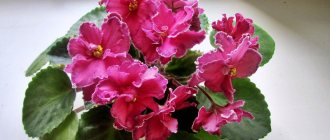The indoor violet is rightly called the princess of floriculture. Its other name, Saintpaulia, was given to the plant in honor of the German ruler Baron Walter von Saint-Paul who discovered it in the African tropical forests at the end of the 19th century. And the third name - Uzambara violet - was given to the beautiful princess because it was found in the mountains of the same name.
Soon, the selection of new varieties began, and about half a century ago, Saintpaulias became the undisputed leaders of home floriculture. There are 8,500 varieties known, but their collection is constantly expanding. Among them are many flowers of domestic selection, including the “Stone Flower” violet.
Violet Georgia
Those who like double, brightly colored flowers will certainly like the Georgia violet, pictured. This variety, selected by T. Dadoyan, is distinguished by lush, long-lasting flowering. The corollas of a catchy pink hue are decorated with a raspberry-lilac coating and a green corrugated frill along the edge of the wavy petals. These flowers look most impressive against the background of dark green foliage.
Reviews
Elena Okatieva. “A very unusual variety. Original and bright. Attracts attention."
The violet attracts many gardeners with its beauty.
Tamara V. “The stone flower requires very careful care, it is slow-witted, it grows buds slowly, but once it blooms, it doesn’t last for one week!”
Violets Arctic Frost
The Arctic Frost violet variety developed by Sorano has a cap of the most delicate white flowers with a wide, blurred border of a dark blue hue. The corollas are simple or semi-double, extremely showy, large and wavy. The foliage is quilted, dark, oval-ovate in shape.
The Arctic frost violet variety sometimes surprises the grower with the appearance of chimeras that produce spectacular flowers with contrasting white stripes in the middle of each petal.
Features of flowering, growth and reproduction
How long does it take to grow an adult plant?
The peculiarity of the variety is its slow growth of green mass . Leaf cuttings do not produce children for a long time; the children that appear very slowly turn into starters. Healthy starters with good care begin to grow faster.
How are varietal characteristics transmitted?
Propagation procedure using leaf cuttings :
- Take a healthy leaf with a long stem;
- Cut off the top of the leaf with a sharp knife;
- We root the cuttings in a small pot;
- Cover with a greenhouse;
- The variety will produce babies in 4 weeks.
What do flower stalks look like?
Peduncle variety:
- Short;
- Dark colored.
Is it possible to achieve cap flowering?
The stone flower produces few peduncles , but due to the size and doubleness of the flowers, it forms a small cap.
Bud lifespan
The variety takes a long time to gain color, the buds remain closed . Flowering duration with proper care is up to three weeks.
Violet Esmeralda
The Esmeral variety is in the collection of two breeders. The Esmeralda violet, bred by E. Lebetskaya, produces large, fuchsia or ripe raspberry colored terry corollas. The flowering is abundant and lush; the head of flowers looks especially advantageous on the even green rosette formed by this variety.
The Esmeralda violet shown in the second photo was created thanks to the work of S. Repkina. This variety produces voluminous double flowers with a diameter of up to 7 cm. The color of the corollas is thick cherry, “delicious”. The edges of each wavy petal are edged with white edging; the center of the corolla has a more saturated color in tone. The foliage is evenly colored in a pleasant dark color.
Caring for a plant at home
Proper watering and fertilizing
High-quality watering is important for Saintpaulias. It is carried out carefully, taking into account the age and condition of the plants. The frequency and volume of watering varies depending on many factors :
- Violet age;
- Substrate type;
- Illumination;
- Microclimate in the room;
- The size of the pot, the material from which it is made.
at different times for different plants , so by watering all the plants in your collection at the same time, you run the risk of flooding some of them and leaving others in dry soil for a long time.
IMPORTANT! Moisture should not pour onto the petioles, leaves, or growing point.
For irrigation, use soft water, standing for 24 hours, at a temperature of 20-220C .
A good choice at home is to water violets with a syringe with a long spout . Choose the volume 100-150 ml. A simple medical device allows you to:
- Pour water in a thin stream;
- Direct it to the edge of the earthen clod;
- Avoiding splashing.
Bottom watering can be carried out occasionally . The pots are immersed halfway in water and left until the moisture wets the entire pot.
IMPORTANT! Frequent use of the method can provoke the appearance of root rot.
There are many ways to deliver nutrients and trace elements to violets. You can always find various fertilizers :
- Sticks;
- Liquid;
- Granular.
ADVICE! Opt for liquid fertilizers. They are easy to dose and simple to use.
Saintpaulias need to be fed during watering.
Fertilizers are carried out according to the rules :
- Consider the age of the plant. A starter plant requires much more nitrogen than a mature plant;
- In order for a violet to produce many high-quality buds, it needs phosphorus;
- Potassium affects the duration of flowering;
- Saintpaulias are more suitable for feeding from above;
- Remember that sometimes, instead of fertilizing, replanting will be healthier for the plant.
Lighting and temperature
The Stone Flower variety prefers western or eastern window sills . On the south side the plant must be shaded, and on the north it should be placed under a phytolamp, especially in the winter months. Be aware of the risk of burns from direct sunlight. If there is too little sun, the foliage may rot and fungus or spider mites will appear on it.
To form an even, neat rosette, the flower must be rotated regularly .
The variety is thermophilic, it is comfortable at temperatures of 20-240C. In this temperature range, violet blooms the longest. During the cold period, the room should not be colder than +140C, otherwise the death of the flower cannot be avoided.
If the thermometer readings are consistently above +280C, the Stone Flower:
- The leaves will turn yellow;
- It will drop flower stalks and buds.
Air humidity
The stone flower is kept at air humidity of 50-60% . If the violet is provided with proper watering and a comfortable temperature, mature plants can grow at a moisture content of 40%.
Soil requirements
Saintpaulias prefer soil with a slightly acidic reaction (pH 5.5-6.5), in addition, it should be well-permeable to air, loose and light.
IMPORTANT! Growing violets without a properly composed balanced soil mixture is a difficult task.
You can make your own soil for violets.
Approximate soil composition :
- Turf – 1 part;
- Leaf – 1 part;
- Sand -1 part;
- High peat – 1 part;
- Use crushed charcoal as a ripper.
Pruning and hygiene
For a violet to bloom profusely, the rosette must include three to four tiers of leaves. When forming a rosette, you can safely remove leaves from the fifth and lower tiers. Be sure to pick off flourishing flower stalks, damaged and wilted leaves.
Saintpaulias living on your windowsill should be inspected once a week. During inspection, pay attention to the following indicators :
- Soil moisture;
- The need to add or loosen the soil;
- Signs of parasites and diseases (wet areas, spots, cobwebs, wilting);
- During the inspection, a rosette is formed, flourishing peduncles, wilted or diseased leaves are removed.
The leaves and petioles of Saintpaulia are covered with hairs, dust actively accumulates between them , this harms the plant and reduces its decorative value. Give violets a hygienic shower regularly. Before the procedure, protect the soil in the pot with cling film or place it in a bag and tie it so that water does not spill onto the soil.
IMPORTANT! The leaves are washed individually under a thin stream of warm water.
Reproduction methods
Violet Stone flower is propagated by :
- Leaf cuttings;
- Or kids.
Transplant rules, rejuvenation
If you find these signs in your Saintpaulia, then it’s time to replant it:
- The plant needs to be rejuvenated or deepened;
- Roots visible from drainage hole;
- There is a suspicion of stagnation of water in the pot (the flower is flooded);
- Violet grows in the same substrate for 2 or more years;
- Signs of nutritional deficiency have appeared.
Saintpaulia should be replanted once a year.
Transfer procedure:
- Remove the roots with a lump of soil from the pot;
- Gently shake off and remove the old substrate;
- Cut off excess leaves, old or diseased roots;
- Place the plant's root system in fresh soil;
- When replanting a violet, the volume of the pot is left the same;
- After a day, water the plant and add soil.
When replanting violets, be very careful . The stone flower is fragile and delicate, it is easy to damage.
Saintpaulia must be regularly rejuvenated . This should be done when the plant reaches the age of 2.5-3 years. Otherwise, the plant will stop blooming or the flowers will be small.
ATTENTION! To revive Saintpaulia, the “head” (the growing point and 2 tiers of leaves) is cut off from the old plant, then it is rooted in water or a greenhouse.
Reminder for a newbie!
Uzambara (Uzumbar) violet is a plant of the Gesneriaceae family, growing in the natural environment of tropical and subtropical regions of Asia, Africa, Eastern Australia, South America and the Indian Ocean islands.
Saintpaulia is a plant named after the Saint-Paul father and son, who brought a plant unknown to Europeans from the Uzambara district (modern Tanzania) in the 19th century, presented for the first time at the international flower exhibition in Ghent in 1893.
Indoor violet has been one of the most popular plants in indoor floriculture since 1927. By 1949, more than 100 varieties had been bred, and today their number exceeds several thousand.
Rooting
- possibly in water, in substrate, moss.
Priming
- purchased soil or a mixture of leaf, coniferous, turf and peat soil in a ratio of 3:1:2:1 with the addition of raising agents (perlite, vermiculite, river sand, crushed sphagnum moss.
Lighting - it is best to place flower pots on western or eastern windows. To ensure that the plant is evenly illuminated from all sides, the pots are periodically rotated. In winter, when daylight hours decrease, you can use artificial lighting - fluorescent lamps.
Caring is a real art and serious painstaking work at the same time, including watering, fertilizing, and creating a favorable humid climate. Water Saintpaulias as the soil dries. The soil must be moistened regularly, but excess moisture should not stagnate in the roots. When watering, you must ensure that water does not get on the leaves. You cannot water the Uzambara violet with cold water. Fertilizing is done with complex mineral fertilizer once every two weeks. Saintpaulia reacts negatively to a lack of nitrogen in the soil. Optimal air humidity is approximately 50%, temperature is 20-22 ° C, without sudden fluctuations and drafts. The leaves of the plant should not touch the window glass. Removal of faded flowers and damaged leaves is carried out regularly.
Reproduction - planting a leaf cutting, part of a leaf, or a daughter rosette. The most popular method is rooting leaf cuttings. The formation of roots and the development of children lasts 4-8 weeks.
Pests are one of the gardener's problems. There are many different types of pests and it is very difficult to classify them. Among Saintpaulia pests, several groups can be distinguished: mites (spider mites, flat mites, transparent mites, etc.), insects (aphids, thrips, springtails, poduras, scale insects, whiteflies, scale insects, etc.), worms (nematodes).
Diseases - distinguish between infectious (gray rot, powdery mildew) and non-infectious diseases (rotting of the stem and root, wilting of the lower leaves, yellowing, leaf spotting, incomplete opening and premature drying, falling of flowers) of plants. The causative agents of infectious diseases are bacteria, fungi, and viruses. To prevent infectious diseases, you should strictly observe the regimes of watering, temperature, humidity, and lighting. Non-communicable diseases usually arise due to poor agricultural practices. They may appear in one instance and not spread to others.
The indoor violet is rightly called the princess of floriculture. Its other name, Saintpaulia, was given to the plant in honor of the German ruler Baron Walter von Saint-Paul who discovered it in the African tropical forests at the end of the 19th century. And the third name - Uzambara violet - was given to the beautiful princess because it was found in the mountains of the same name.
Soon, the selection of new varieties began, and about half a century ago, Saintpaulias became the undisputed leaders of home floriculture. There are 8,500 varieties known, but their collection is constantly expanding. Among them are many flowers of domestic selection, including the “Stone Flower” violet.
“Violet” art by K. Morev
One of the breeders whose varieties of violets have become real favorites among flower growers is Konstantin Morev from Moscow. Even as a child, he became interested in plant breeding. And this was facilitated by his acquaintance with the luminary of “violet” art, Boris Mikhailovich Makuni, who lived in the same building as the boy’s family.
According to experienced Saintpaulists, Konstantin Morev’s flowers are in no way inferior to the best foreign varieties . As the breeder himself says in one of his interviews, for him selection is constant selection and improvement, and this process is endless.
Despite the fact that Konstantin’s main profession is not related to biology, he is a programmer by training, and “from his pen” came such popular varieties among flower growers as Frosty Cherry, Blue Fog, Greenhouse Effect, Pink Panther, Wedding Bouquet and many others . His new varieties are awaited; people specially come to exhibitions for them. Let's get acquainted with the description of the famous varieties of violets of this talented breeder.
Distinctive features of Saintpaulias bred by K. Morev
Saintpaulia varieties selected by Konstantin Morev are distinguished by a neat rosette, lush, abundant flowering that lasts a long time and interesting colors of leaves and flowers (there are many variegated varieties, and tricolor coloring of the petals is also often found). His varieties are characterized by a harmonious combination of a neat rosette, strong peduncles and well-developed root systems. The varieties adapt well to growing conditions. They convey varietal characteristics well.
In his work, Konstantin Morev adheres to the rule that if he takes on a job, do it well. His violet varieties undergo rigorous testing and lengthy selection before being presented to the Saintpaulian community. Many seedlings are rejected without becoming a full-fledged variety . But Konstantin’s works are so good that they also find their adherents and connoisseurs.
On our portal you will find information about other violets that were bred by equally talented breeders, including Natalya Puminova, Elena Korshunova, Tatyana Pugacheva, Evgeny Arkhipov, Alexey Tarasov and Tatyana Dadoyan.
Important : No matter how wonderful the selected species and varieties of violets are, only competent care of the plants and the creation of comfortable conditions for them will allow you to fully enjoy the true beauty of the flowers and see everything that the author-breeders put into them.
They do a lot of work on breeding new varieties, which lasts for many years, but the task of every gardener who decided to give a new home to this amazing flower is to take care of these little ones, and they, in turn, will delight their owners with lush and long-lasting flowering.
Advice from flower growers
Advice from professionals will help you grow a Stone Flower:
- When there is too much light, the leaves bend, which hinders the growth of flower stalks and increases their fragility.
- Violets are afraid of drafts. When ventilating, they are covered from cold air. Otherwise, the leaves become stained and the plant may die.
- To increase immunity, strengthen roots and better flowering, plants are fed with yeast by pouring warm water with added sugar and leaving for several hours.
- Sugar or glucose diluted in water perfectly stimulates the growth of young violets. Spraying with this solution is done once a month.
